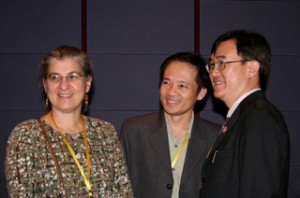What is ecosan?
What is ecosan?
According to Wikipedia, http://en.wikipedia.org/wiki/Ecosan Ecological sanitation, also known as ecosan or eco-san, is a sanitation process that uses human of blackwater and sometimes immediately eliminates fecal pathogens from any still present wastewater (urine) at the source. The objectives are to offer economically and ecologically sustainable and culturally acceptable systems that aim to close the natural nutrient and water cycle.
Thinking systemically and closing loops. Arne Panesar of GTZ and SuSanA defined sustainable sanitation as comprising health and hygiene, environment and natural resources, technical solutions and operations, finance and the economy, and sociocultural and institutional issues. All parts of the sanitation chain require appropriate management and financing tools. By failing to understand ecosan systemically, we lose sight of feedback loops. This is also a reason why infrastructure in industrialized cities is deteriorating and it documentation is not yet causing alarm.
According to Panesar, ecological sanitation…
is not a specific technology, but a new philosophy of dealing with what is presently regarded as waste and wastewater for disposal
considers human excreta and wastewater not as wastes but as natural resources
applies the basic natural principal of closing the loop by using modern and safe sanitation and reuse technologies
opens up a wider range of sanitation options than those currently considered
Peak Phosphorus Human waste reuse guru Arne Rosemarin of the Swedish Environmental Institute spoke on the need for productive sanitation systems in the context of Peak Phosphorus http://phosphorusfutures.net/peak-phosphorus. Although phosphorus has remained under the radar, President Obama has an advisor on Peak Phosphorus and an announcement from the US, which is expected to deplete commercially viable phosphorus reserves in 25-30 years, is expected soon.
Phosphate experts Cordell et al. http://phosphorusfutures.net/who-we-are summarize the opportunities for recovering phosphorus as follows. http://phosphorusfutures.net/phosphorus-recovery A key opportunity to meeting the goal of global food security lies in the often overlooked link between addressing hunger and sanitation. Phosphorus (P) is a critical nutrient input in agriculture and …also a constant nutrient stream in sewage emerging from human settlements that is often considered an environmental pollutant. Each year, we produce 3 million tonnes of P in our urine and faeces globally. If displaced nutrients (like P) are recirculated back to agriculture from where they first came, we can sustain food production into the future and decouple communities’ dependence on globalized and increasingly inaccessible P fertilizer markets.
Reconnecting sanitation and urban planning. In the third presentation in the session on ecological sanitation, Christoph Luthi of EAWAG/SANDEC http://www.sandec.ch/ in Switzerland pointed out that starting this year more than half of the world’s people will be urban dwellers. He’s currently finishing a new “Roadmap for Sustainable Sanitation in Cities”, which argues for reuse and for getting urban planners and sanitation experts from North and South to collaborate.
The disconnect between the two fields dates from the mid 19th century when centralized solutions took over and proved unsustainable. The question today is which mix of centralized and decentralized technologies is inappropriate. In other words, how far can rural sanitation penetrate the peri-urban (and suburban)?
According to Wikipedia, Ecosan is based on the systematic implementation of reuse and recycling of nutrients and water as a hygienically safe, closed-loop and holistic alternative to conventional sanitation solutions. Ecosan systems enable the recovery of nutrients from human faeces and urine for the benefit of agriculture, thus helping to preserve soil fertility, assure food security for future generations, minimize water pollution and recover bioenergy. They ensure that water is used economically and is recycled in a safe way to the greatest possible extent for purposes such as irrigation or groundwater recharge.[1]
 Day 1 of the World Toilet Summit ended with a special session of the Sustainable Sanitation Alliance, or SuSanA, a network of creative and knowledgeable practitioners who came together at the 2007 World Toilet Summit in Delhi.
Thinking systemically and closing loops. Arne Panesar of GTZ defined sustainable sanitation as comprising health and hygiene, environment and natural resources, technical solutions and operations, finance and the economy, and sociocultural and institutional issues. All parts of the sanitation chain require appropriate management and financing tools. By failing to understand ecosan systemically, we lose sight of feedback loops. This is also a reason why infrastructure in industrialized cities is deteriorating and it documentation is not yet causing alarm.
According to Panesar, ecological sanitation…
Day 1 of the World Toilet Summit ended with a special session of the Sustainable Sanitation Alliance, or SuSanA, a network of creative and knowledgeable practitioners who came together at the 2007 World Toilet Summit in Delhi.
Thinking systemically and closing loops. Arne Panesar of GTZ defined sustainable sanitation as comprising health and hygiene, environment and natural resources, technical solutions and operations, finance and the economy, and sociocultural and institutional issues. All parts of the sanitation chain require appropriate management and financing tools. By failing to understand ecosan systemically, we lose sight of feedback loops. This is also a reason why infrastructure in industrialized cities is deteriorating and it documentation is not yet causing alarm.
According to Panesar, ecological sanitation…
- is not a specific technology, but a new philosophy of dealing with what is presently regarded as waste and wastewater for disposal
- considers human excreta and wastewater not as wastes but as natural resources
- applies the basic natural principal of closing the loop by using modern and safe sanitation and reuse technologies
- opens up a wider range of sanitation options than those currently considered
